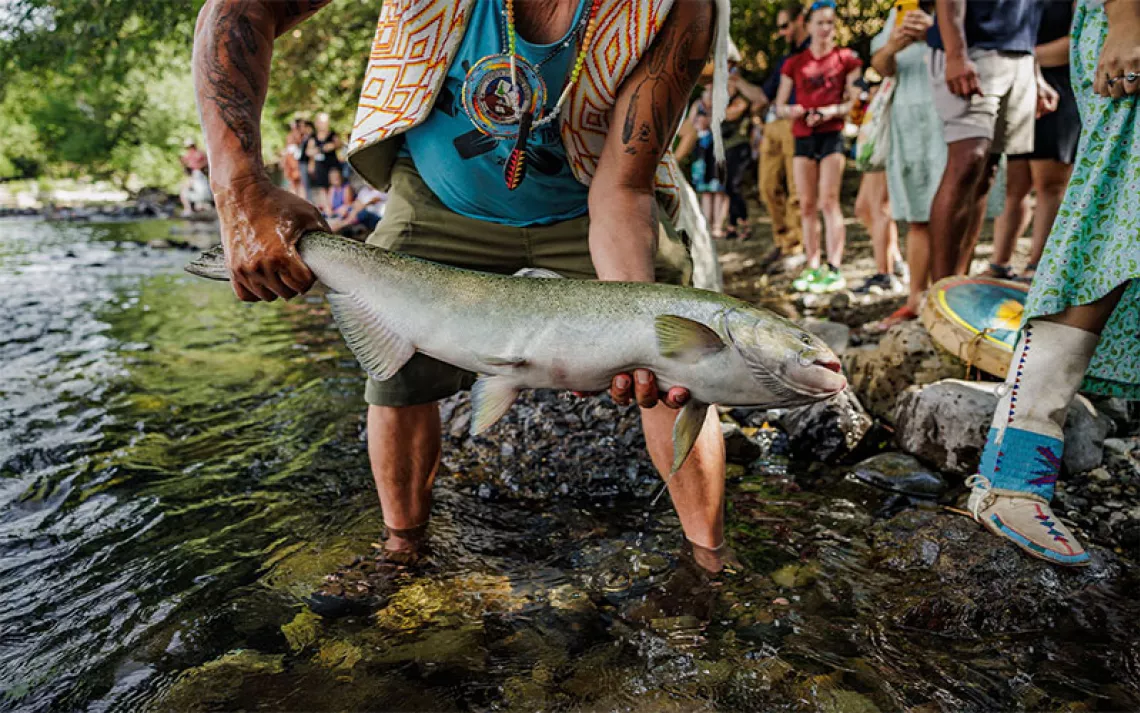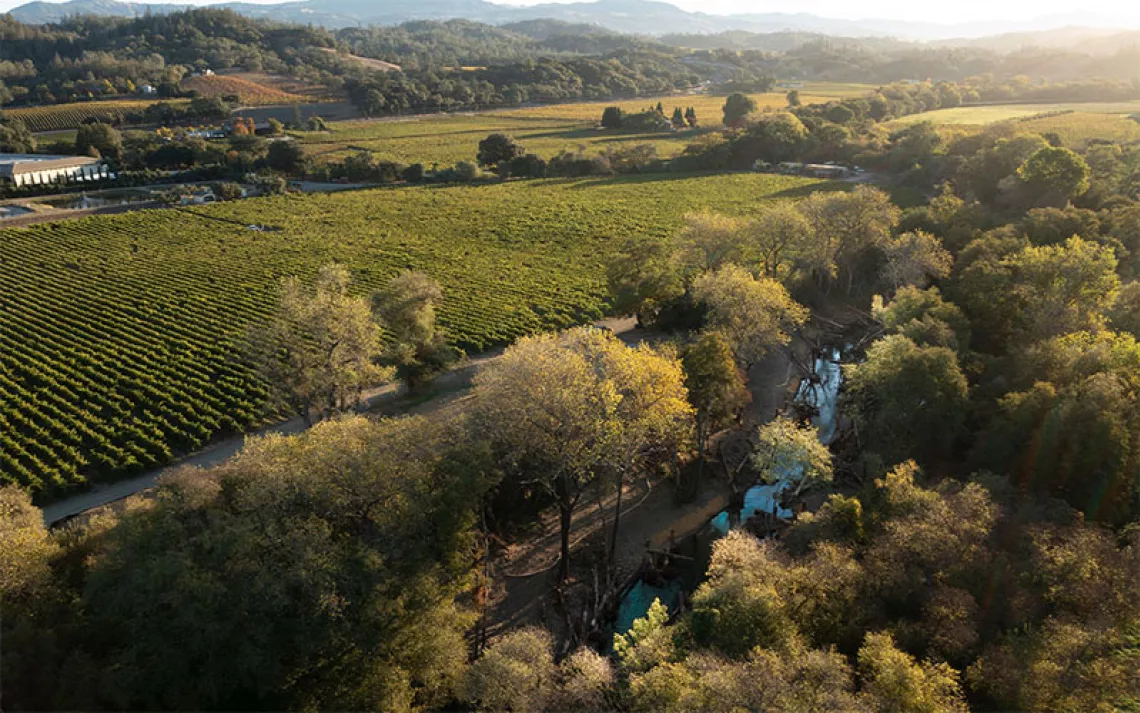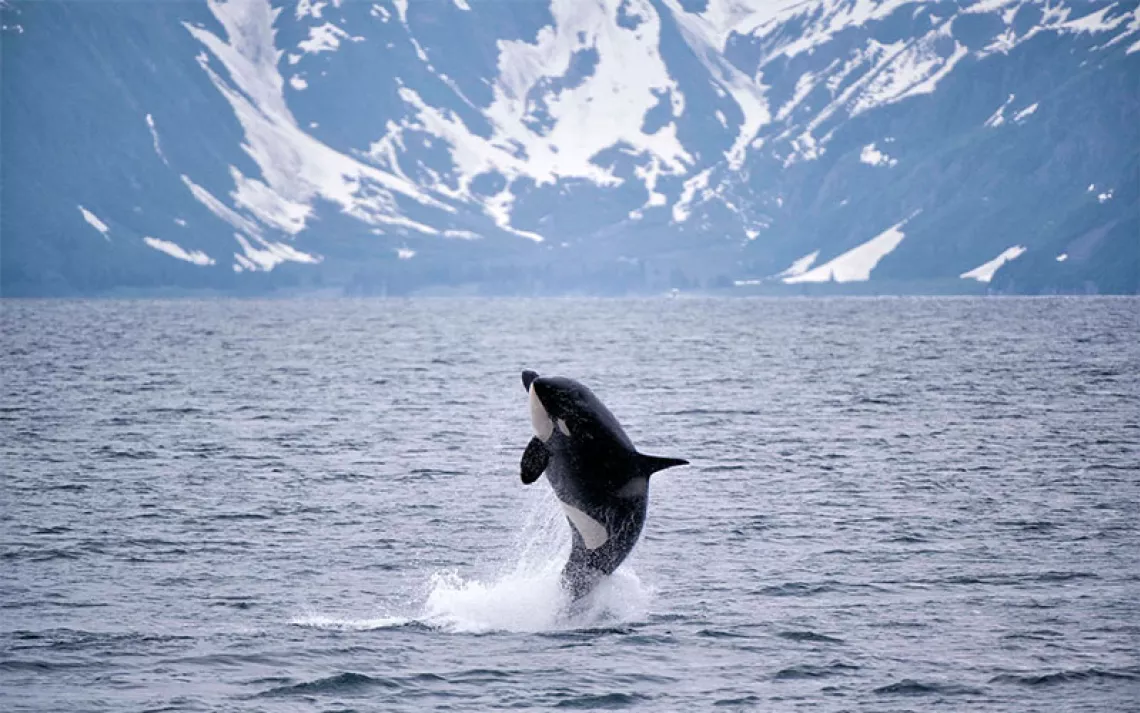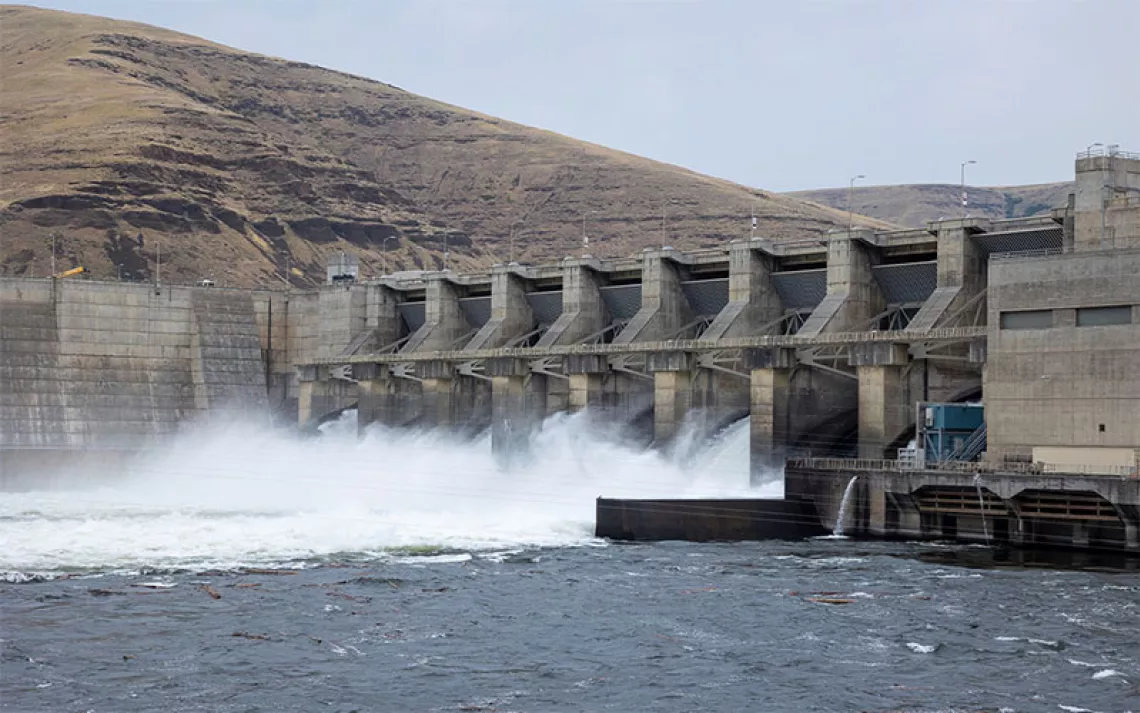Salmon and Coal Face Off in Alaska
Salmon are the lifeblood of Alaska. Will the state allow PacRim Coal to dig through their spawning grounds?
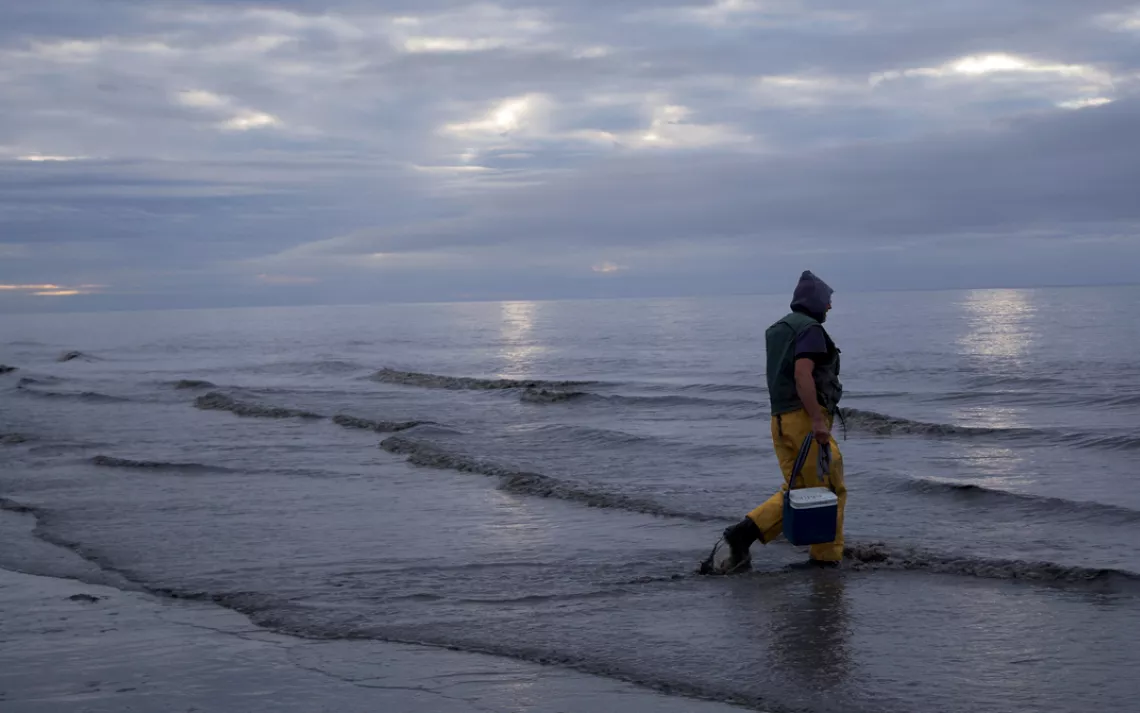
Early morning on fishing day in Beluga, Alaska, near the site of a proposed PacRim Coal mine.
IT WAS THE SUMMER OF 1948 when Ward Grant and his mother, Fidelis, were released by a cannery boat into the muddy isolation of a fishing beach in Southcentral Alaska. The boats still operated then—it was before the canneries collapsed as the violent sea battered the bluffs out from under them.
Ward and Fidelis had traveled up from California to join Frank, Ward's father and Fidelis's husband, who'd been living in Alaska on and off for a decade. He fished in the summers and trapped each winter. Fidelis was from Los Angeles, where she modeled and worked as a secretary for Universal Studios. Smoke-and-shoulder-pads 1940s Hollywood was her natural environment. The couple had married in Los Angeles and conceived Ward while Frank was training there to fight in World War II. Now back from the war, Frank insisted that his son be raised in the Alaskan wilds. Fidelis obliged because of the picture of Alaskan life that she had formed in her mind—a quaint cabin in a beach community like Malibu, California. On the day she and Ward arrived at their new home (it was called Three Mile Beach then but is now called Beluga), she wore gray slacks, a blouse, and a sweater and carried Samsonite luggage. She offered her first impression—"That looks like a nice green meadow"—and stepped out of the boat, sinking up to her hips in the moss-covered intertidal mud.
THE FOUR-YEAR-OLD WARD'S bush education began quickly. In his first summer there, he touched salmon, and he touched coal. The salmon were hard-bodied and slimy. He was too small to carry them in his hands, so he hugged them to his chest. In shoals large enough to make the ocean surface boil, they charged Cook Inlet from the Pacific, then turned up rivers and into the silent forests of Southcentral Alaska, where they spawned. The coal moved in the opposite direction. The nearby Chuitna River carried it out of the forests and into the sea, where it rode waves onto the beach. It came in barklike black and umber cakes that left a dusty residue on his hands.
The coal chunks were not yet tethered, in Ward's mind, to the Beluga Coalfield, the sprawling layer of compressed peat that today could mean the end of salmon fishing in Beluga and the surrounding area. In 1948, that coalfield was still a largely unknown store of combustible energy hidden beneath the inland swamps, and the salmon came so abundantly that they seemed unstoppable. Coal was something you put in the stove to keep your cabin warm when storms roiled the ocean like a cauldron.
Back then, the notion of mining coal on an industrial scale in the lands surrounding Beluga would have seemed absurd. Inland from the beach are dense forests—one might call it an Alaskan jungle—and amid those, an expanse of swamp. Bear and moose are everywhere. Snow falls heavily in winter. Even the coast is a rough place if you do not find happiness in drizzle, gray light, fish fragrance, and a brutal wind called the Cannon, which fires at Beluga from across the inlet, often for days at a time.
But Frank couldn't imagine living anywhere else. There were a handful of others like him. A woman named Mary Smith lived out her years alone and blind in a cabin near the beach after her husband and three sons all died in fishing accidents. That's how powerfully life in Beluga drew on certain people. And while Fidelis learned begrudgingly to fire a rifle and make sourdough pancakes on a coal stove, Ward came into the grip of the bush.
That fall, as the lush forest grayed and the salmon run ended, the Grants moved into Frank's wintering cabin, about 10 miles down the beach and a few bends up a river. (Today the area is called Grant's Cabin on some maps.) Winter came suddenly, heavily, lonesomely. Frank would leave for days at a time to gather animals from his fifty-odd miles of traps. Fidelis and Ward were sequestered in the cabin, snowdrifts covering the windows, the shortwave radio blaring tinny sounds. Near the new year, Fidelis got pneumonia, and her adventure in wild Alaska ended with a terrifying three-hour boat ride to Anchorage, against the Cannon, lying sick beneath a tarp while Frank steered their dory through a winter storm. "I remember my dad yelling for me to steer while he poured gasoline into the motor," says Ward. "It was fun." When the hospital discharged her, Fidelis returned to California.
The next year, Frank bought the family a house in Anchorage and took winter jobs as a longshoreman and a taxi driver. Fidelis came back. And every summer, Frank took Ward to the fishing beach at Beluga. When Ward was 16, he got a loan from the bank to buy his own fishing site. Fish paid for him to leave the beach and go to college. And they called for him to come back.
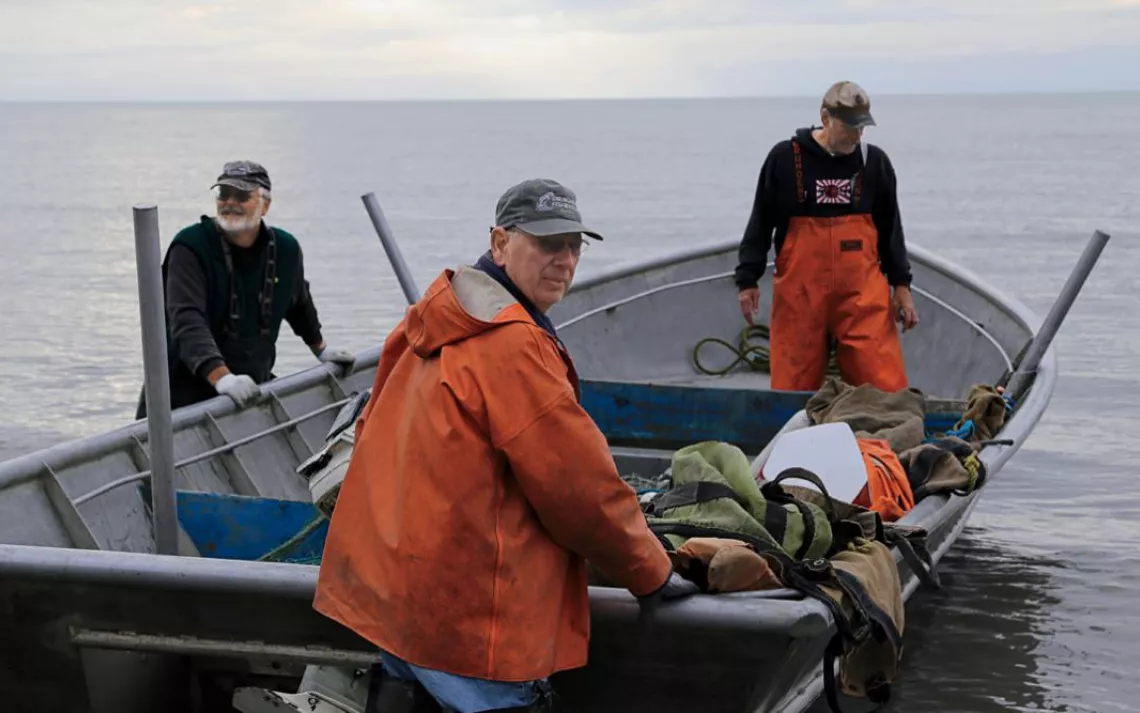
On a productive day, Terry Jorgensen, Ward Grant, and Rick Volk (from left) can catch over 1,000 salmon.
ON A JULY MORNING IN 2015, Ward Grant stands on the shore at Beluga, hoping that the water before him holds shoals of salmon. He looks at his watch. "Six fifty-seven," he shouts to his partners as they wait for the fishing window to open. "Six fifty-eight," someone disagrees. The sky above the inlet is distinctly Alaskan. As through a prism, pale light shines on ragged clouds. Everything is tinted chrome. For these fishermen, it is not a bad sky but not a fish sky either. A fish sky drizzles. A bad sky shines bright and blue. Because salmon lack eyelids, the sun drives them into deeper, darker waters—away from shore.
Three generations of Grants have now fished this beach. Ward is the second. The third is his nephew, who fishes just down the beach, and the first was Frank, revered for his fishing prowess until he died several years ago, fervent and strong at 97. Frank worked the nets until 90, then passed his site to his fishing partner, Terry Jorgensen, a six-foot-eight former college basketball player and retired history teacher. Ward lives on a golf course in Virginia and comes to Beluga for a few weeks each year, ostensibly to help Jorgensen. But the truth is that he likes to walk in the tidal mud, to stand amid the snaking rivers and the bear-ridden woods where his father made him into an Alaskan. He's not sure how much longer all this will be around.
About 10 miles inland, a company called PacRim Coal is currently seeking approval to exhume the Beluga Coalfield. The project would excavate at least 15 square miles of pristine wildlands, destroy a dozen miles of salmon spawning grounds, and turn this quiet fishing beach into a coal-shipping terminal, ending the Grants' legacy in Beluga and setting a scary precedent—Alaska has never before allowed anyone to mine through a salmon stream.
Seven o'clock comes—the beginning of a twice-weekly 12-hour window during which they're allowed to catch fish—and Jorgensen and his partner, Rick Volk, push off in a small aluminum dory, stringing a net out behind them. Ward rides an ATV down the beach to where the next net will go. The fishermen will connect each net to a buoy and let it float there like the net on a tennis court. Passing fish are entangled. This technique, called set netting, is the same one that Frank used when he first came to the beach. As they motor toward the buoy a few minutes after seven, the shoreward end of the net is already alive with salmon.
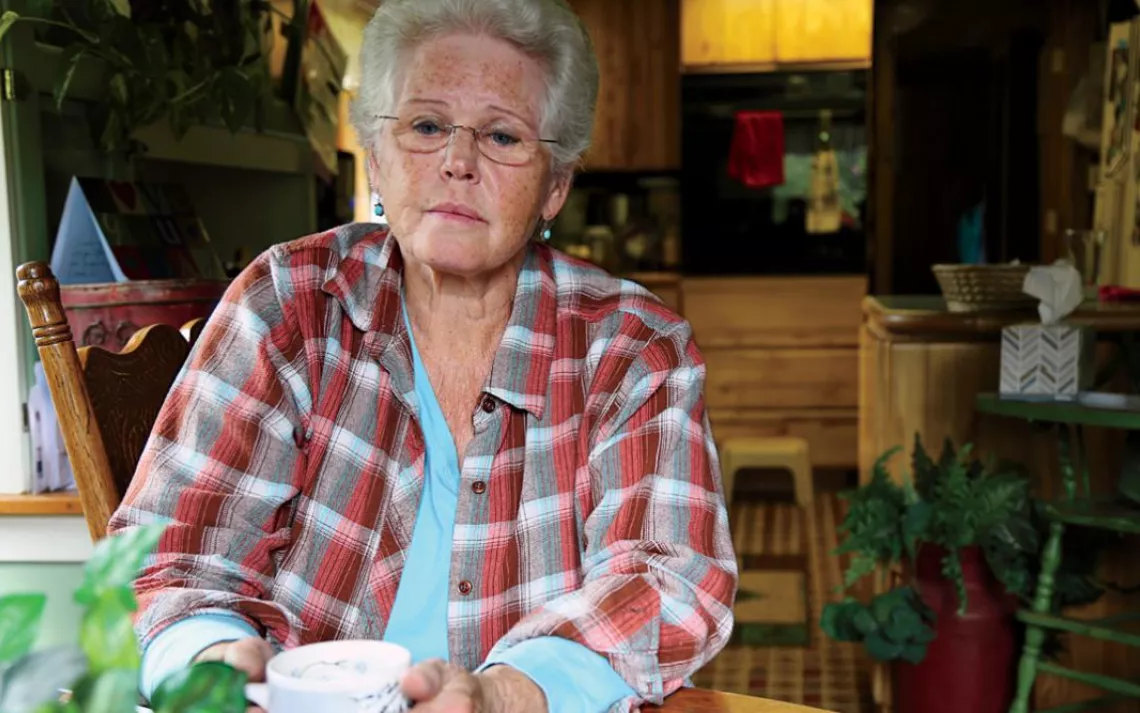
Judy Heilman, Chuitna Citizens Coalition president and resident of Beluga, has been one of the most powerful critics of PacRim's mine.
LATER THAT MORNING, Jorgensen stands up in his boat and points to the sky. "That's where they want to put the conveyor belt," he says. Above Jorgensen's fishing site, PacRim would install a conveyor belt to transport crushed coal from the beach bluffs to an artificial island, from where the coal would be loaded on barges and ferried to Asia. He can almost see the structure when he looks up, and he can imagine the island on the horizon, a mirage of gravel and steel. It will rise in the path of the salmon that swim toward his site. "They want to put a Berlin Wall between me and the fish," he says, yanking another salmon from the net. "They want to bring in tugboats and barges, cranes banging stuff. Salmon hate noise." The section of ocean that PacRim will lease starts just feet away from Jorgensen's site. The island and the conveyor belt would be built in critical habitat for the endangered Cook Inlet beluga whale. There are only about 300 left. A 2011 report on the project by the Center for Sustainable Economy declared that the "impacts to marine ecosystems are likely to be diverse and long-lasting."
Jorgensen pulls a section of net into the dory. One sockeye is entangled, its body curved into that active pose of a stuffed sport fish. Today, sockeyes (or red salmon) are going for $2 a pound, making them the best fish he can pull out of the Pacific. "That's a good salmon. It's big, and it's hard as a rock," he says, grabbing it by the head. He untangles it and tosses it into the middle section of the boat, which is already shin-deep with salmon. To walk through that part, you sort of wiggle your foot downward with each step. The salmon redistribute like liquid inside a water balloon.
With his imposing size and slightly pedagogical air, Jorgensen has fought the mine project obsessively since the 1990s. Unlike Ward, he was not raised on the beach. He sought it out as an adult in the early 1980s. He wished to work in the wild, to fish long days and get caught up in the whirlwind of nature. At that time, Beluga was slightly more populous than it had been in Ward's childhood—a natural gas plant was installed nearby in the 1960s, and that brought with it a slew of workers—but all Jorgensen had to do was head inland a few miles to where the land was paradise. "I've never seen anything like it," he tells me, his eyes set on some dream world floating in front of his face. "The silvers were in there, and the trout and the eagles. And the bears. The bears were just thick in there. They still are." Early on, he cast into Lone Creek, a tributary of the Chuitna River, and brought in a 30-pound king salmon. It was the first fish he caught in Beluga. He threw it back.
Today, Lone Creek marks the eastern boundary of the proposed mine site. Just beside it, PacRim would drain and dig up a 15-square-mile plot of wetlands and forest that Middle Creek—another major Chuitna tributary—runs directly through. The mine's long-term atmospheric impact would be profound. Over 25 years, PacRim would remove 300 million tons of subbituminous coal and be responsible for 991 million metric tons of carbon dioxide emissions, according to the 2011 report. But their lease area constitutes just one section of an estimated 1.2-billion-ton coalfield where other leases are held. The rest of the coal would be more attractive to mine and ship if PacRim is allowed to build an export terminal.
The local impact of the mine is not as easily quantifiable. Moose calving grounds would be destroyed. The nearby native village of Tyonek relies on these moose, and salmon from the river, for subsistence; the average resident harvests about 200 pounds of fish and meat each year. The coal coming out of this mine would be crushed and stored in gigantic piles while it waits to be transported to Asian markets. The effect of coal dust blowing off of these piles and over the Chuitna River watershed is not precisely known, but the dust would blanket the surrounding forest.
What really concerns the people of Beluga is that salmon, a renewable resource at the heart of the Alaskan identity, could be sacrificed for coal that will be burned abroad. "We still have fresh Alaska salmon," says Judy Heilman, the head of a local group called the Chuitna Citizens Coalition, which is fighting the mine. "We need to think about the future for our kids and our grandkids and their kids."
The Chuitna is one of the top salmon-producing rivers in Cook Inlet, but, like many rivers in Alaska, its runs have been on the decline. The nonprofit American Rivers named it the sixth most endangered river in the United States, calling it the "lifeblood of the region" and "emblematic of true Alaskan wilderness." The mine would be a devastating blow.
PacRim has proposed a plan to restore Middle Creek after the underlying coal has been exhausted, but doing so does not seem feasible. Above the coal seam, which is 300 feet deep, a complex layering of aquifers, rock, sediment, and surface vegetation creates ideal salmon-spawning grounds in the bed of Middle Creek. To access the coal, PacRim would drain and pulverize all of this, forever altering not only the stream itself but also everything that facilitates it. Many scientists consider the restoration of this ecosystem to be impossible.
To dramatize what the mine would do to the watershed, Jorgensen once brought a jar of water with a chunk of coal in it to a meeting with PacRim and the Army Corps of Engineers. While he accosted them with a list of 40 issues that were unaddressed in PacRim's plan for the mine, the coal dissolved. By the end of the meeting, the water was black, and the PacRim employees were staring into their laps. "I was telling them, 'This water, that's the river,'" says Jorgensen. "I almost put a salmon fry in there, but we all know what would've happened to that."
THROUGHOUT THE MORNING and early afternoon, Jorgensen and his partner float the length of their three nets, untangling the fish by hand, one at a time. In 12 hours, they can catch more than 1,000 salmon. The work is grueling. The net loops onto gills and fins. It lassos the bodies of fish, sometimes several times over. The untangling of the fish—the "picking," as it is called—takes strong hands and a constitution that allows you to yank, squeeze, and twist living things. The pickers pluck a gill on each fish as soon as it is untangled. This allows the fish to bleed out. Bled fish are worth more money. The nets often trap coal chunks. The occasional flounder is tossed back like a Frisbee. While the salmon wait to be picked, seals sometimes see them as easy prey—an underwater wall of paralyzed food. The seals take small bites, seemingly at random, from many different fish, effectively diverting them from Costco's shelves to Jorgensen's freezer. On the other hand, a fish whose eyes have been pecked out by a seagull is still fair game for grocery stores, so long as its fillets are pristine.
Before long, the boat bottom is full of blood. Fish scales attach themselves sequinlike to Jorgensen's waders, and large quantities fall into the bloody water, where they swirl galactically, brutal but gorgeous. It's a good day to be fishing off Beluga.
Usually the fishermen spend the gray northern evenings boxing their catch and loading it onto bush planes, but tonight Copper River Seafoods will send a boat, called a tender, to retrieve the catch. Its crew will meet Jorgensen and Volk 100 yards out at sea, where they will use a small crane to lift bags of salmon, separated by species, out of Jorgensen's boat and into theirs. They will weigh the fish and take their temperature. Colder fish are worth more—low 40s is good. The tender is a relief for Jorgensen, whose hands ache after fishing days.
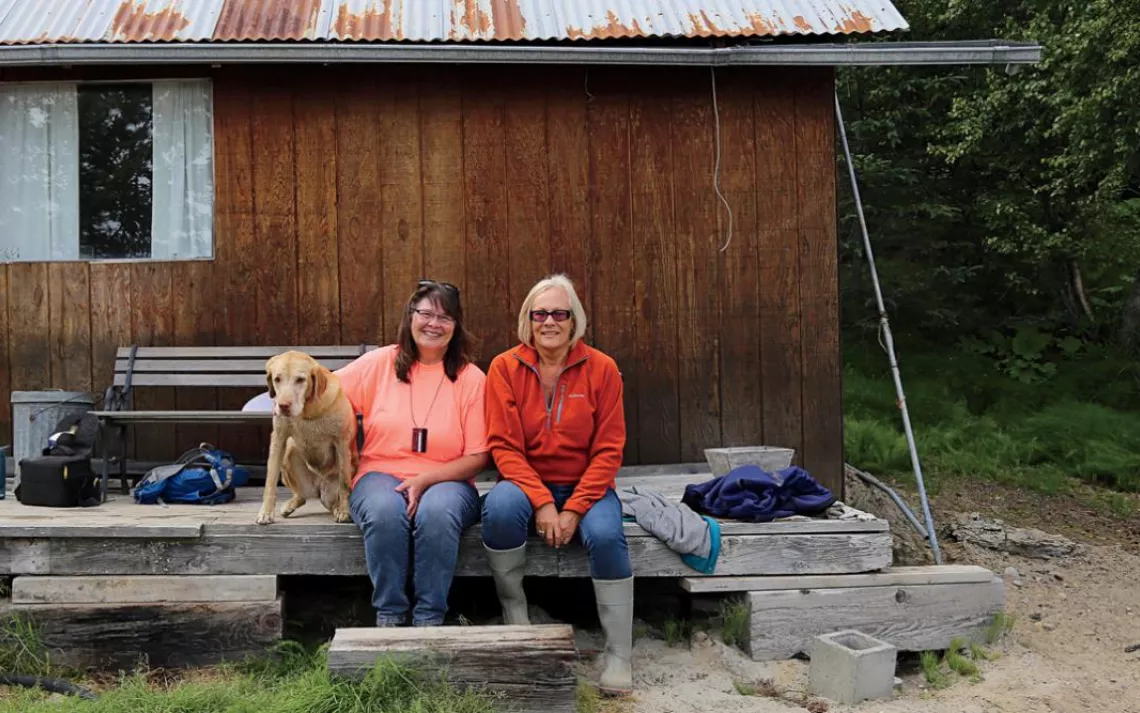
Marilyn Barksdale (left, with Lyn Jorgensen) spent much of her childhood on the beach in Beluga.
IN HIS SISTER'S CABIN ABOVE THE BEACH, Ward, still wearing his thigh-high boots and bright-orange rubber jacket, takes a sip of raspberry tea. It's about three in the afternoon, and he has come in for a break.
Ward produces a plastic box full of photographs. He lays them out on the table. "There's Dad," he says, pointing to a black-and-white snapshot of a tall, thick-necked man in waders.
Ward's sister, Marilyn Barksdale, drops a plate of toast on the table. She was adopted by the Grants as an infant, when Ward was nine. Her first bed was a Johnson outboard-motor box. Now she's 60 but looks much younger. Her father used to take her hiking in the woods around Beluga. He crashed through the trees with a loping gait. On her first fishing day, she cried at the boatful of dead creatures, and he told her to put dollar signs on them. In the winter, she used to follow him and Fidelis to the Elks Lodge in Anchorage and watch them ballroom dance. She thinks he is still on the beach, watching the fishing site through the eyes of an eagle, bringing the fish or sending them away.
"When Dad died, he was so strong, it took four orderlies to hold him down," Marilyn says.
"And here's Mom," says Ward. It's a glamour photo of a woman in a white ruffled shirt with shoulder pads.
Ward lays out another photograph. It's him, Frank, and Fidelis. The six-year-old Ward is struggling to lift Runt, the Alaskan malamute that walked the coast with him in 1948. "Dad could still outpick everyone on the beach when he was 90." His eyes turn red. He wipes his nose on the sleeve of his jacket. Marilyn starts crying, too. "It's not that I miss him," Ward says. "It's just, before he died, he said, 'Don't ever let them take this place.'"
His tea unfinished, he goes outside, mounts his four-wheeler, and drives back down to the beach, where Jorgensen and Volk are taking a break. They've caught several thousand pounds of fish. There are hints of drizzle. The nets are unmanned—available for seagulls. The men talk for a few moments about the tender, how it will save them hours of work. Then Ward gets back on the ATV, points it down the beach, and says, "I'd better go chase some birds off our nets." And he is gone, his orange coat flapping in the Cook Inlet wind.
This article appeared as "The Red and the Black" in the November/December 2015 print edition of Sierra.
WHAT YOU CAN DO
Ask EPA Region 10 administrator Dennis McLerran not to issue permits to the Chuitna coal mine project. Click here for more information.
 The Magazine of The Sierra Club
The Magazine of The Sierra Club
